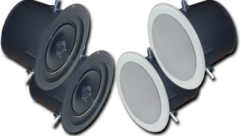
Outdoor AV: Installation at Central Park West, Part 1
Mar 7, 2011 5:53 PM,
with Bennett Liles
Listen to the Podcasts
Editor’s note: For your convenience, this transcription of the podcast includes timestamps. If you are listening to the podcast and reading its accompanying transcription, you can use the timestamps to jump to any part of the audio podcast by simply dragging the slider on the podcast to the time indicated in the transcription.
You’ve got an outdoor venue that can host a crowd from several hundred to several thousand and it has to sound right for any event. James Cioffi from New Jersey’s Boulevard Pro is going to let us know how they handled that job in the amphitheater called Central Park West. That’s coming right up on the SVC podcast.
James it’s great to have you with me on the SVC podcast from Boulevard Pro in Oradell, New Jersey and tell us about Boulevard Pro. What do you do and how long has Boulevard Pro been around?
Well Boulevard started in 1986. We’re celebrating our 25th year in business this year and it’s a milestone for us. My twin brother, Anthony, and I started the company many, many years ago. We were touring musicians and we started by opening up a rehearsal studio which then turned into a production business which back aligned a full event production which lead its way into the installation business and we’re happy to say that we’re on the “A-list” here in the New York tri-state area and we do quite a different type of job every day. We’re very, very diversified. We have a home theater division, we actually have a home theater retail pro-audio store and as well as a production company. So having my brother running the production end and I run the design/build end has been pretty easy for us and it’s been really nice because we’re able to run two parts of the company simultaneously without them really interfering with themselves. [Timestamp: 1:59]
Well it sounds like you’ve always got a lot of plates spinning and this new project that came up in, I think it’s Overpeck Community Park, in New Jersey an outdoor venue they call it Central Park West. How did that venue come up out of what I heard was a former land fill?
It was a former land fill and you know what’s funny when my brother and I were 16 years old we used to work for the Teaneck Board of Ed in the summer and we would go and they would throw everything in this place. I don’t think there were any PA standards, anything at this time. But it’s right at the intersection of the New Jersey Turnpike and the George Washington/Lincoln Tunnel exchanges so it’s quite a busy area. It has been overlooked for many years and what happened was they were deemed some money many years ago that grew and grew and grew and by the…I guess the good fortune of the residents in these towns that the governing bodies were able to hold these states to the fire and made them fulfill on a promise that was, I think, 50 years old. So I don’t know how that happened but it did happen and we were invited in as a consultant and when we saw the original design/build plans we were able to effectively get our influence there and we turned what would be a pretty vanilla audio system into a really great live venue. So it worked out on both ends for us. [Timestamp: 3:29]
And this was put together by the Bergen County Parks Department and they wanted a performance facility in that park and of course these days it’s not just a stage and a couple of speakers. Everybody expects the kind of clear sound they hear on TV and the big shows. So what did the Bergen County people tell you they wanted for this facility?
What happened was we were brought into the bid pretty much after it was designed. And this gentleman, John Biale who is project manager for the Bergen County Parks, is a pretty forward-thinking guy and what he thought the original plans of the sound system that was specked were going to be inefficient so he went out and looked into the pool of many great design/build companies in the area and we just happened to be one of the ones he called on and we convinced him that we were the guys for the job and they were agreeable to that and we went on from there. So our design was… “If we’re going to spend all this money, let’s try to get something that would be actual useable in a professional production environment,” and we’re happy to say that that’s exactly what happened. [Timestamp: 3:34]
And you had a little bit of an inside track having seen the situation and what they wanted to do but when you saw what they wanted did you have any initial concerns or questions from the outside of the project?
It was more just spoken-word type of system—just a sound over a large area. Almost like a stadium system that we do and things like that but it was not anything for high definition or any kind of a venue performance type of sound system and the space is a huge…it’s a huge Proscenium stage—it really is a monumental achievement for what this place was. When we were brought into it obviously it was just a hole in the ground. We had no expectations of what it would look like and after we were invited to see the plans we just said, “Hey, I think there may be a better way to go about this.” And that was an odd thing for us because we’ve been involved in a lot of state-designed builds and I’ve never seen one that changed but this one did. [Timestamp: 5:36]
This is a pretty large area. What kind of seating capacity? Or do they even have an official seating capacity? Is it just an open area they can just fill up with seats for any occasion?
It’s really set up as an amphitheater. Its set in…down a hill and the suggested amount was 3,000-3,500 people and it’s quite comfortable at that. We did do a…the first real high profile live venue concert there in September and 7,500 people showed up and the system was able to cover it so we were quite happy with that as well. [Timestamp: 6:12]
Outdoor AV: Installation at Central Park West, Part 1
Mar 7, 2011 5:53 PM,
with Bennett Liles
Well I guess that can be a good thing—having more people than you figured were going to show up for an event since you’ve got plenty of room out there. I understand you put in a Yamaha LS9 digital audio console in there. Why did you choose that for this particular place?
We have a very, very longstanding relationship with Yamaha Commercial Audio and we are proponents of digital technologies. We really felt that a digital console, and especially the LS9 because of the footprint of it, we were able to put that off to stage left. It actually acts as a bridge between larger productions and smaller productions but it’s recallable, it’s a very simple user interface, we are able to control it over a Cat-5 with our laptop so it really just was a really key element and it just seemed to fit perfectly and we’ve done many, many, many LS9 installations in churches, in schools and in our rental division we have them in our rental division. So we’re very familiar with that console and we really feel it’s a bulletproof piece and we never have an issue about thinking if it’s going to work or not. [Timestamp: 7:2]
Obviously a big plus being familiar with the capabilities of the system and when you saw the situation here I would think that flexibility would have to be a big part of this because you have a very open area where the audience can be arranged in a lot of difference ways. Where’s the FOH position? You said it was over on the side, is it fixed or can the board be moved out front?
Well the console lives in a fixed position but we can control the console via Cat-5 runs that we ran through the space. I mean the FOH position is 165ft. away and is actually a pad built with power and we ran a simple audio snake, I think it’s 12 channels of audio back and forth for communications for any kind of sundry items and then we run the console over a Cat-5 and for larger productions we bring in a Yamaha M7ES with a digital snake and we use those same Cat-5 runs in different locations and it’s completely flexible. It’s really been wonderful. It can be in a set and forget mode or it can be in full production mode so it really is a nice way of doing it. The park obviously doesn’t have trained technical people and the administrator and the supervisor of the park are well aware of how to recall a scene. We burned in some simple scenes and give them a couple of wireless mics and CD playback for his one scene. And depending on the scale of the event we man it accordingly. The other good news about it is that the rental end of our company…we almost built in a rental job for ourselves because any of the larger events they call us to man the system. So it’s very rental-friendly. [Timestamp: 9:05]
OK so when you were putting this thing in obviously it’s outside so there are going to be some weather factors to deal with. What was the biggest challenge on this? Was there any kind of a hurry up on it or was it just the fact that it was outside?
Well the Proscenium Stage is a structure we have stage right is electric stage left is audio so we have a room that’s air-conditioned and heated and for us it’s a very, very fortified type of a structure. But the actual installation was on the fast track because this was up and running for the July 4th weekend. We were awarded the contract in late March so there was a lot that had to go in. We had to work with the general contractor who is a huge operation. So it’s not like we’re working with a local contractor we’re working with a huge corporation—really had to get our conduit runs under control. These guys, they’re not audio savvy guys so we had to go through that with them but they did a wonderful job and provided us everything that we needed to do. We had our crew. The good news is that our warehouse is very local to this site so it really was a five-minute ride from our warehouse. But we went and did it—we project managed everything that we could do. We pulled all the cabling that we had to do and we got it done. In this kind of environment, in this kind of economy I don’t think there’s many people to say “No”—at least not in New York. [Timestamp: 10:31]
Right and it looks like you had several advantages that you pressed to your credit. You’re close by and even though it’s outside you already had a clear picture of what they wanted and I want to thank you for being here James to tell us about it. And for Part Two we can get into the Nexo GOS 12 line arrays and where you put the amps and some of the more specific things but thanks for being here for Part One.










